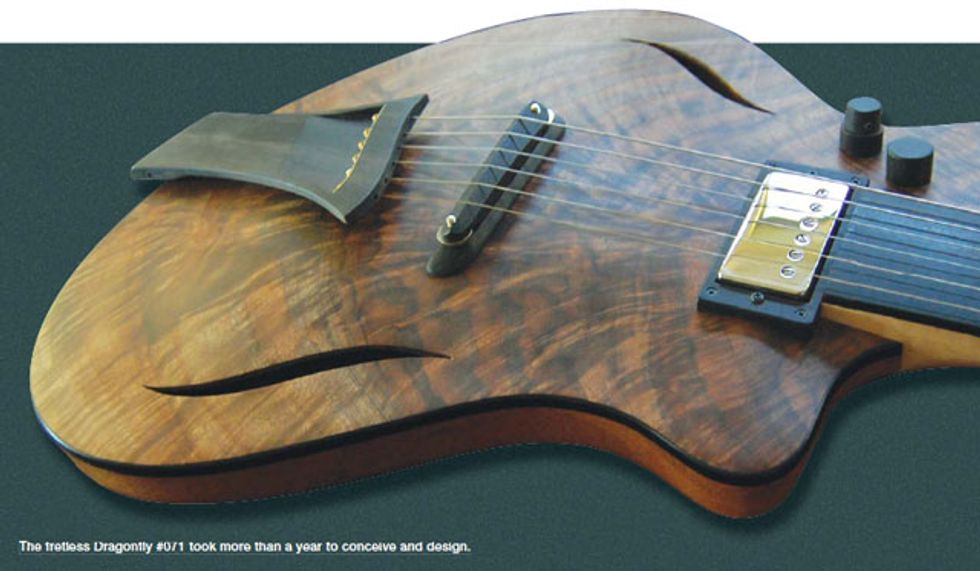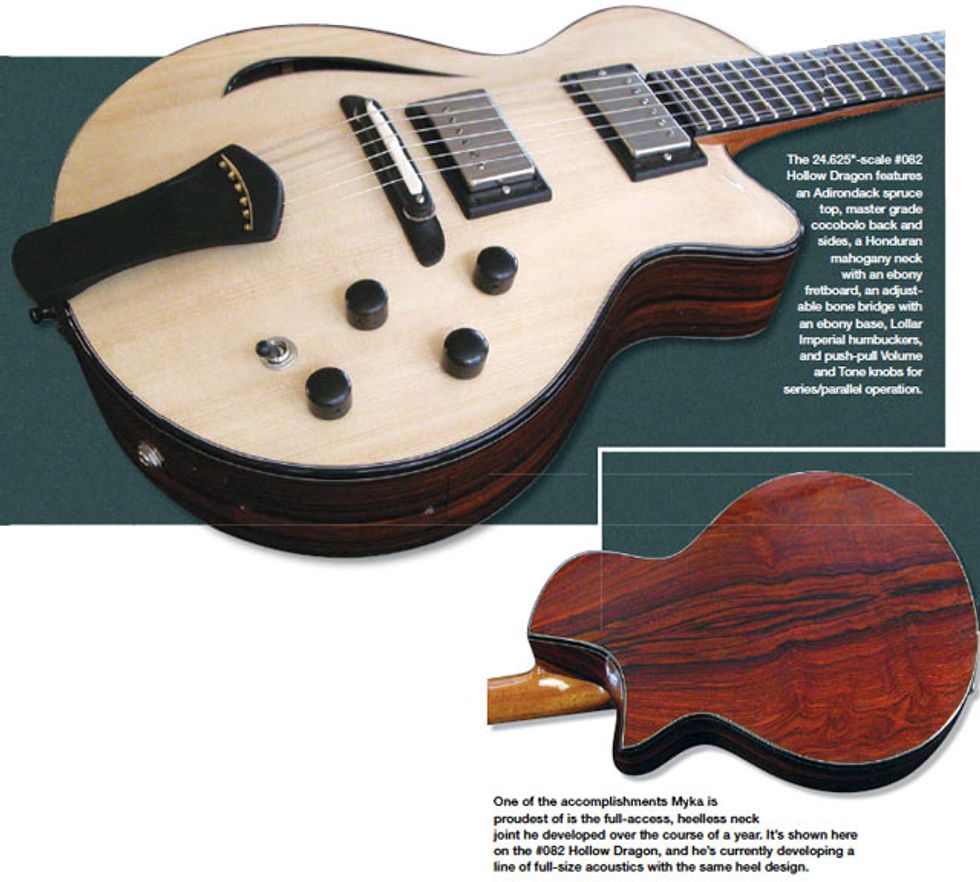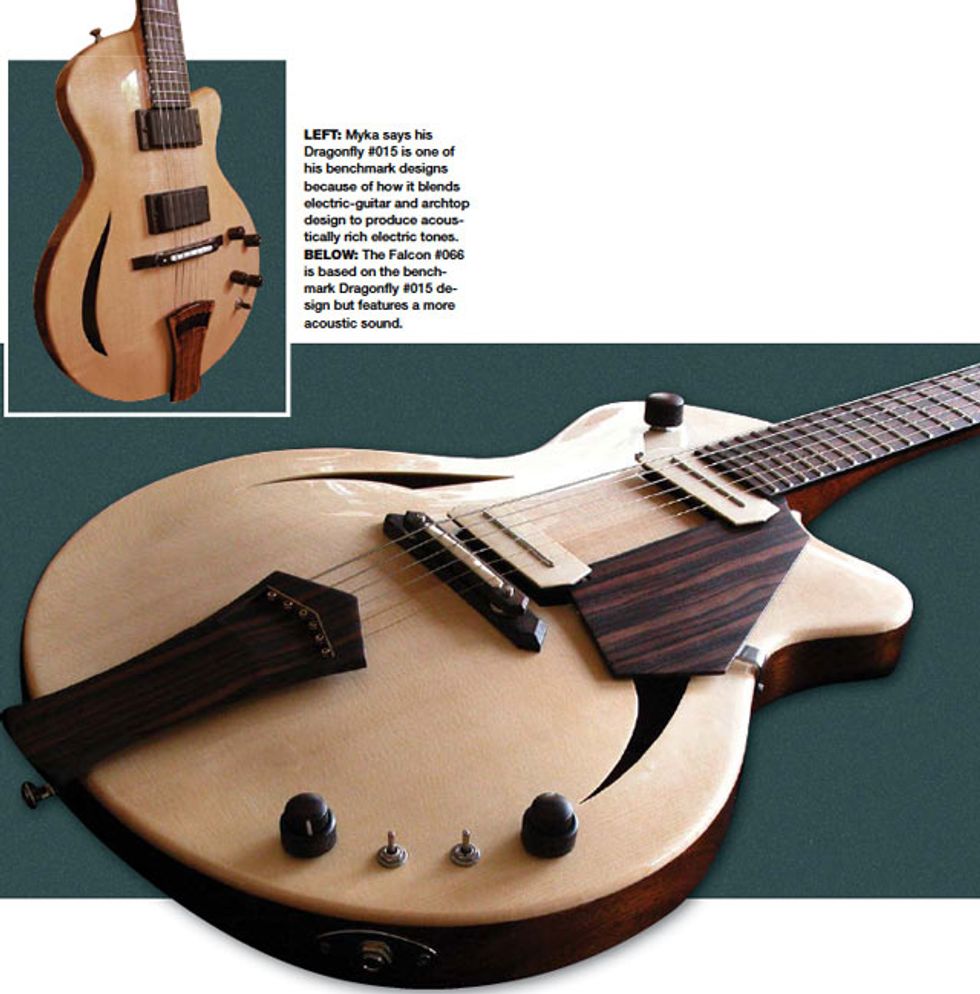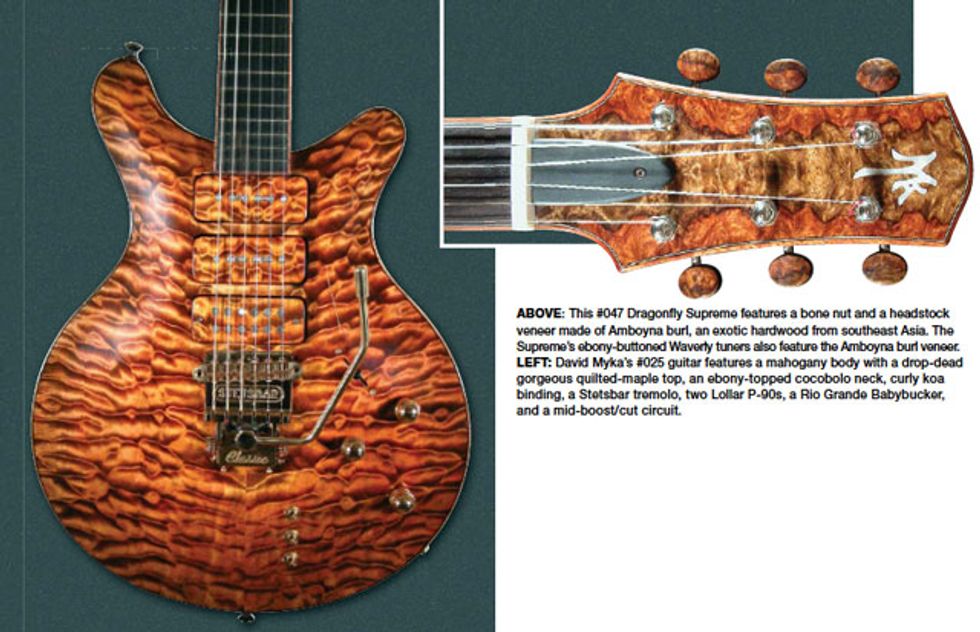The term “custom guitar” means different things to different people. To some it means slapping cool Duncan pickups, a Hipshot bridge, and Sperzel tuners on a Warmoth body and neck. To others it means a guitar put together by a name builder with a body shape, neck profile, components, and wood chosen from a menu of options. However, to David Myka of Myka Custom Guitars, custom means custom—as in, you can commission a solid, hollow, or semi-hollow guitar in any shape you want. Or, if you’re so inclined, you can design the body shape and the Seattle-based luthier will bring your idea to life and fine-tune it to become the instrument of your dreams. Alternatively, you can choose one of Myka’s existing models as a starting point for a custom guitar. If you’re ultra-picky and have primo access to a good stash, you can even supply your own woods.
Myka is driven by a desire to push the envelope with guitar design. A self-taught luthier, he started building guitars in his teens using old 6-strings he found in the trash and gathering what he could from broken radios for parts. He took wire from transformers and wrapped it around 6-penny nails to make crude pickups. The first guitar he built had nuts and bolts for tuning keys.
Then, Myka purchased Steel-String Guitar Construction by Irving Sloane. The book’s last chapter showed James D’Aquisto building an archtop guitar, and that image got Myka hooked—as you can tell by the homage-paying contours in the latter’s single-cutaway archtops. After digesting the D’Aquisto chapter, Myka started making carvedtop guitars. Many years later, in 2001, he took a class from Harry Fleishman to learn more about acoustic guitars.
Currently Myka guitars have a waiting period of six to 12 months (or more, depending on the level of customization). To get the inside story on these extraordinary instruments, we asked Myka to share his perspective and philosophy of guitar making.
What type of players are drawn to Myka guitars?
I tend to attract people who are looking for something very specific they haven’t been able to find elsewhere. It could be something completely custom or something that is inspired by a classic, but built to the highest standards. The truth is, I love a good challenge, and when I get a napkin sketch or a wild concept, I won’t hesitate to build it.
Do you have standard offerings as well, or is everything custom?
The core of my work is custom construction. However, I do have a standard set of about five body shapes to choose from, as well as custom design services. Each guitar shape can be made into a solidbody, archtop electric, or acoustic instrument. Quite often, it’s a hybrid of these construction styles. Every guitar includes a custom scale length, neck carve, and pickup and electronics layout, with the option of any binding and trim woods available. I also offer acoustic flattop and archtop designs, as well as any custom designs that can be made into an instrument without breaking the known laws of physics. So I guess that covers everything!
Have you ever turned away work before?
Yes. I do not build replica guitars. My goal is to expand the concept of the guitar, to refine and evolve it into something new. I certainly take inspiration from classics, but I prefer to work with my own designs.
How many guitars do you build a year?
Currently, I build about 16 to 20 guitars a year. That number is growing, and my plan is to build about 60 guitars next year, including my personal custom work. The standard work is done more efficiently, but the full-on custom work always takes extra time, so I manage it on a separate schedule.
What’s the ordering process?
Typically, there is an initial conversation about what type of guitar you want to have built. This leads into the design phase, which can last for a few weeks or more as every detail is pored over until a design emerges. For new shapes and guitar concepts, this phase can take months. I actually had one design phase—the fretless Dragonfly #071—last over a year. But, in the end, the design was nearly perfect—at least in my mind. The design phase ends with a spec. Then I work out a rough idea of the building timeline and I start when the time slot opens up in my schedule. During construction, I update my clients with photos and emails to keep them in the loop.

Who are some of your favorite players, and do they influence your designs?
Jimmy Page and Alex Lifeson are the first two guitarists whose tone I noticed. Throughout middle school I was into heavy metal and hard rock, and in high school I got my first taste of improvisational fusion music with Jerry Garcia and the Grateful Dead. This led me to guitarists like John McLaughlin and Pat Metheny, and on to David Torn, Terje Rydpal, David Fiuczynski, John Abercrombie, Paco de Lucia, and Fareed Haque. Frank Zappa was another revelation for me. These musicians influence my work as a luthier in ways I can’t begin to describe, since I often have them playing while I work. Tonally, I use them as references and will sometimes investigate their guitars and setups as a concept to work toward. But, honestly, the most influential guitarists are my clients, since the design process can be fairly intense.
Are you involved in all aspects of the building?
Yes. Currently, I’m working with apprentices who will eventually assist me in producing a range of standard designs that will be fully customizable. This will be done under my supervision, and I’ll personally complete the final details to ensure these are true Myka guitars. I’ll continue to build the fully custom guitars completely by myself.
Would you consider using CNC machines?
Well, there is a lot of controversy about CNC machines. Like all tools, they are limited, and the skill in using them lies in understanding what they can and cannot do—just like my Dupli-Carver. I have no issue with using any available technology, so long as there is a distinction in the processes between what is automated and what must be done by hand. What makes my guitars unique in the marketplace are the processes of selecting the woods, tuning the bodies to work together with the necks, and carving and tuning the tops and backs. Regardless of whether the instrument is acoustic or electric, these tasks will always be done with the skill and knowledge that can only come from an appreciation of what is pleasing to the human ear and the experience of enjoying music. The only machine capable of that is the human body. A machine can certainly help get to the point where this important work begins.
What do you think about the Plek fret-leveling machine?
Actually, I think extensive fretwork is unnecessary on a new instrument. After reading the many chapters on leveling frets in every guitar- making book, it occurred to me that the problem was not with the frets, but with the generally accepted way that necks are built. Over the last six years, I have spent my time perfecting my neck processes and have achieved zero fret buzz without ever leveling the fret surfaces. I simply dress the fret ends and polish them. When this is done, the fretboard is stable and straight and is predictable under string tension. So, the Plek machine seems redundant.
What are your favorite woods and why?
For electrics and archtop electrics, I love to use claro walnut for the tops. It is such a gorgeous wood and has this dark tonality that appeals to me musically. Another favorite is korina, because of its rich midrange tones that are perfect for that classic carved-top sound. Paired with a nice set of humbuckers or a good P-90, korina just sings. I also love to use rosewood necks for my electrics. Matched with a resonant body, a rosewood neck brings a complexity of tone that is hard to describe. I recently acquired some Brazilian Kingwood that was imported in 1929, and this wood is fast becoming one of my favorites.
What is it about the Kingwood that you’re digging so much?
I have a collection of Brazilian rosewood fingerboards, and I hear the same complexity of tone during my tap test. The deep low end is there, along with excellent sustain and that crisp, glassy top end that Brazilian is known for. In a blind tap test, I am not sure I could tell the difference—it’s that good!

Which components are outsourced?
I outsource hardware and electronic components, such as tuning keys, pickups, and electronic switches. Oh, and cases. In the future, I will be machining more of my own hardware. But all of the woodworking is done in-house and always will be.
How do you go about selecting and mating pickups for your guitars?
That really depends on the design and tonal goals of the project, but my clients tend to drive this decision based on what they want from the guitar. I am fortunate that we have Jason Lollar nearby. I use his pickups in most of my guitars because they are well made and they bring out the nuances of my guitars quite well. His ability to nail a custom design is uncanny. If I have a selection I need to choose from, I use my ears.
How has your approach to building guitars evolved or changed over the years?
My approach has always been experimental, and that has allowed me to explore construction concepts and theories that are unorthodox and somewhat radical. I also get to design and build some pretty out-there stuff. I still believe the guitar is an acoustic instrument, and this has shaped the way I design and work. But my craft continues to evolve due to the fact that I am constantly learning about what makes a great guitar. What I’m building today I feel is light-years ahead of where I started. I hope to look back in five years and think the same thing about today.
What do you consider to be your most unorthodox and radical theories and approaches?
From a theoretical perspective, I do not differentiate between acoustics and electrics. I see them at opposite ends of the same spectrum. The concept of a solidbody acoustic allows me to incorporate ideas from both ends of the spectrum. Without giving too much away, I will say that I have developed acoustic designs that allow characteristics of a solidbody to shine through, and vice versa. The design and construction techniques play out more in my semi- and full-hollowbody and acoustic-style guitars, which are much more complex structurally. Being self-taught, I design bracing systems to fit the design I am working with. So the “out-there” construction concepts relate to blocking and tonal-structural bracing designs that are very different than the typical X- and parallel-bracing systems employed by the vast majority of guitars today, both acoustic and electric. Just take a look at the Flaretone design or my Hollow Dragon to see some of these concepts at work.
I understand you burned a guitar you deemed a “tonal dud.” Others might have passed it off as a factory second.
The guitar that I burned was a simple case of catharsis. It was a very early guitar for me—my seventh—and I was exploring the concept of solidbody acoustics. I was looking for the sweet spot, in terms of chambering depth as it relates to the overall resonance. Well, I found it and proceeded to pass it by rather quickly. I routed away too much vital wood and the guitar lacked the vibrancy and liveliness my other guitars had. It sat for two years before I finally got tired of thinking of ways to fix it. So to get it out of my mind, I got together with another builder who also had a problem guitar, and we took them out back and had a burning.
What amps do you use for testing guitars?
I use a Siegmund Midnight Special, which I like because it brings out the acoustic qualities of electric guitars. It gives me insight into how the small choices add up in the finished instruments.
Tell us about your full-access, heelless acoustic neck joint.
The full-access neck heel is the most amazing neck joint ever, what else do you need to know? Seriously, this neck joint came out of a year-long design concept to bring electric guitar playability to the acoustic realm. The prototype design was built into a 3"-thick guitar body, and it has the best neck access of anything I have ever built, solidbodies included. I only wish it wasn’t so time consuming to construct. But the success of the design makes it worthwhile, as there are a number of benefits over a traditional acoustic neck joint. Because of the solid coupling, the notes have consistent tone and resonance all the way up to the last fret. Also, the neck geometry is stabilized to an extent that it should never need a neck reset.
What’s in store for you in the future?
Full-sized acoustics with full-access neck heels, of course! It is the culmination of my quest for the perfect acoustic guitar for electric players. And, yes, there will be archtops with the new heel design or some variation. Also, in the next few months I will be introducing an exciting new series of guitars featuring the Skyway tremolo.

What is it about the Skyway that excited you enough to design a whole series around it?
The Skyway takes a new approach to the tremolo that results in a near-frictionless system, with direct acoustic coupling to the body. This results in a trem that has the tuning stability and tone transfer of a hardtail bridge. It is quite incredible actually. In addition, they are very lightwieght, which makes them attractive to me for unconventional usage. I can’t say too much more about the new designs right now except that they will be unique in the marketplace.
Tell us about some of your benchmark guitars.
The first benchmark guitar for me was my own personal solidbody, serial #001. This was the first electric guitar where I deliberately applied all of the acoustic principles I had learned from Harry Fleishman. The result was an electric guitar that had amazing depth, clarity, and a complexity—or, better yet, a musicality—that my instruments had never had before. I realized I was onto something when I got a comment at a guitar show from a gentleman who said he never liked electric guitars before, but found mine to be very musical. The next benchmark is the Dragonfly design, starting with #015. This guitar blended the framework of an electric guitar with an archtop to produce an acoustically rich, electric-fusion guitar. It is still my most popular model and one of the most flexible, in terms of tonal variety and design. I have built several versions with different levels of hollowness, and each one is a successful design in its own right. The Falcon #066 and the Hollow Dragon #082 both follow in this series, as the design becomes more acoustic in nature, yet remains firmly rooted in electric guitar.
Which guitars are personal favorites?
A while back, I built an all-Madagascar-rosewood electric that was just amazing. That guitar could do anything, and it was beautiful and smelled so good! Recently, I built a fantastic Dragonfly (#092) that’s simply stunning. The tones were beautiful and the guitar just felt so good to play. But my true favorite is always the one I’m going to build next—it’s an obsession.
Do you ever have a hard time letting go of a guitar?
Oh yeah, it can be tough. I sometimes wish I could keep one for myself. But my chosen path is to provide the tools. The best thing is to hear the music played with these instruments. That makes it worthwhile.








![Rig Rundown: Russian Circles’ Mike Sullivan [2025]](https://www.premierguitar.com/media-library/youtube.jpg?id=62303631&width=1245&height=700&quality=70&coordinates=0%2C0%2C0%2C0)


























